Mantis shrimp
| Mantis shrimp | |
|---|---|
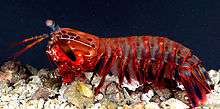 | |
| Odontodactylus scyllarus | |
| Scientific classification | |
| Kingdom: | Animalia |
| Clade: | Euarthropoda |
| Subphylum: | Crustacea |
| Class: | Malacostraca |
| Subclass: | Hoplocarida |
| Order: | Stomatopoda Latreille, 1817 |
| Superfamilies and families [1] | |
|
Bathysquilloidea
Gonodactyloidea
Erythrosquilloidea Lysiosquilloidea
Squilloidea Eurysquilloidea Parasquilloidea | |
Mantis shrimps, or stomatopods, are marine crustaceans of the order Stomatopoda. Some species have specialised calcified "clubs" which can strike with great power, others have sharp forelimbs used to capture prey. They branched from other members of the class Malacostraca around 400 million years ago.[2] Mantis shrimps typically grow to around 10 centimetres (3.9 in) in length. A few can reach up to 38 cm (15 in).[3] The largest mantis shrimp ever caught had a length of 46 cm (18 in) and was caught in the Indian River near Fort Pierce, Florida, in the United States.[4] A mantis shrimp's carapace (the bony, thick shell that covers crustaceans and some other species) covers only the rear part of the head and the first four segments of the thorax. Varieties range from shades of brown to vivid colors, as there are more than 450 species of mantis shrimp. They are among the most important predators in many shallow, tropical, and sub-tropical marine habitats. However, despite being common, they are poorly understood as many species spend most of their life tucked away in burrows and holes.[5]
Called "sea locusts" by ancient Assyrians, "prawn killers" in Australia[6] and now sometimes referred to as "thumb splitters" – because of the animal's ability to inflict painful gashes if handled incautiously[7] – mantis shrimps have powerful claws that are used to attack and kill prey by spearing, stunning, or dismembering. In captivity, some larger species can break through aquarium glass.[8]
Ecology
Around 400 species of mantis shrimp have currently been discovered worldwide; all living species are in the suborder Unipeltata.[9]
These aggressive and typically solitary sea creatures spend most of their time hiding in rock formations or burrowing intricate passageways in the sea bed. They rarely exit their homes except to feed and relocate, and can be active during the day, nocturnal, or active primarily at twilight, depending on the species. Unlike most crustaceans, they sometimes hunt, chase, and kill prey. Although some live in temperate seas, most species live in tropical and subtropical waters in the Indian and Pacific Oceans between eastern Africa and Hawaii.
Claws
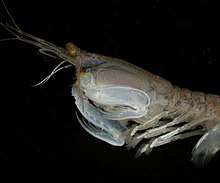
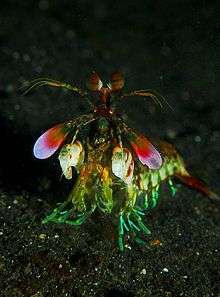
The mantis shrimp's second pair of thoracic appendages has been adapted for powerful close-range combat with high modifications. The appendage differences divide mantis shrimp into two main types: those that hunt by impaling their prey with spear-like structures and those that smash prey with a powerful blow from a heavily mineralised appendage type club. A considerable amount of damage can be inflicted after impact with these robust, hammer-like claws. This club is further divided into three sub-regions: the impact region, the periodic region, and the striated region. Mantis shrimp are commonly separated into two distinct groups determined by the type of claw they possess:
- Smashers possess a much more developed club and a more rudimentary spear (which is nevertheless quite sharp and still used in fights between their own kind); the club is used to bludgeon and smash their meals apart. The inner aspect of the terminal portion of the appendage can also possess a sharp edge, used to cut prey while the mantis shrimp swims.
- Spearers, on the other hand, are armed with spiny appendages topped with barbed tips, used to stab and snag prey.
Both types strike by rapidly unfolding and swinging their raptorial claws at the prey, and can inflict serious damage on victims significantly greater in size than themselves. In smashers, these two weapons are employed with blinding quickness, with an acceleration of 10,400 g (102,000 m/s2 or 335,000 ft/s2) and speeds of 23 m/s (83 km/h; 51 mph) from a standing start.[10] Because they strike so rapidly, they generate vapor-filled bubbles in the water between the appendage and the striking surface—known as cavitation bubbles.[10] The collapse of these cavitation bubbles produces measurable forces on their prey in addition to the instantaneous forces of 1,500 newtons that are caused by the impact of the appendage against the striking surface, which means that the prey is hit twice by a single strike; first by the claw and then by the collapsing cavitation bubbles that immediately follow.[11] Even if the initial strike misses the prey, the resulting shock wave can be enough to stun or kill.
The impact can also produce sonoluminescence from the collapsing bubble. This will produce a very small amount of light within the collapsing bubble, although the light is too weak and short-lived to be detected without advanced scientific equipment. The light emission probably has no biological significance but is rather a side-effect of the rapid snapping motion. Pistol shrimp produce this effect in a very similar manner.
Smashers use this ability to attack snails, crabs, molluscs, and rock oysters, their blunt clubs enabling them to crack the shells of their prey into pieces. Spearers, on the other hand, prefer the meat of softer animals, like fish, which their barbed claws can more easily slice and snag.
The appendages are being studied as a micro-scale analogue for new macro-scale material structures.[12]
Eyes

The eyes of the mantis shrimp are mounted on mobile stalks and can move independently of each other. Mantis shrimp are thought to have the most complex eyes in the animal kingdom and have the most complex visual system ever discovered.[13][14][15] Compared to the three types of photoreceptor cells that humans possess in their eyes, the eyes of a mantis shrimp have between 12 and 16 types of photoreceptors cells. Furthermore, some of these shrimp can tune the sensitivity of their long-wavelength colour vision to adapt to their environment.[16] This phenomenon is called "spectral tuning" and is species-specific.[17] Cheroske et al. did not observe spectral tuning in Neogonodactylus oerstedii, the species with the most monotonous natural photic environment. In N. bredini, a species with a variety of habitats ranging from a depth of 5 to 10m (although it can be found up to 20m below the surface), spectral tuning was observed, but the ability to alter wavelengths of maximum absorbance was not as pronounced as in N. wennerae, a species with much higher ecological/photic habitat diversity.
Each compound eye is made up of up tens of thousands ommatidia, clusters of photoreceptor cells.[14] Each eye consists of two flattened hemispheres separated by parallel rows of specialised ommatidia, collectively called the midband. The number of omatidial rows in the midband ranges from 2 to 6.[13][14] This divides the eye into three regions. This configuration enables mantis shrimp to see objects with three parts of the same eye. In other words, each eye possesses trinocular vision and therefore depth perception. The upper and lower hemispheres are used primarily for recognition of form and motion, like the eyes of many other crustaceans.[13]
Mantis shrimp can perceive wavelengths of light ranging from deep ultraviolet (UVB) to far red (300 to 720 nanometres) and polarized light.[14][18] In mantis shrimp in the superfamilies Gonodactyloidea, Lysiosquilloidea and Hemisquilloidea, the midband is made up of six omatodial rows. Rows 1 to 4 process colours while rows 5 to 6 detect circularly or linearly polarized light. There are 12 types of photoreceptor cells in rows 1 to 4, four of which detect ultraviolet light.[13][14][18][19]
Rows 1 to 4 of the midband are specialised for colour vision, from deep ultraviolet to far red. Their UV vision can detect five different frequency bands in the deep ultraviolet. To do this, they use two photoreceptors in combination with four different colour filters.[20][21] They are not currently believed to be sensitive to infrared light.[22] The optical elements in these rows have eight different classes of visual pigments and the rhabdom (area of eye that absorbs light from a single direction) is divided into three different pigmented layers (tiers), each for different wavelengths. The three tiers in rows 2 and 3 are separated by colour filters (intrarhabdomal filters) that can be divided into four distinct classes, two classes in each row. It is organised like a sandwich; a tier, a colour filter of one class, a tier again, a colour filter of another class, and then a last tier. These colour filters allow the mantis shrimp to see with diverse colour vision. Without the filters, the pigments themselves range only a small segment of the visual spectrum: about 490 to 550 nm.[23] Rows 5 to 6 are also segregated into different tiers, but have only one class of visual pigment, the ninth class, and are specialised for polarization vision. Depending upon the species, they can detect circularly polarized light, linearly polarised light or both. A tenth class of visual pigment is found in the upper and lower hemispheres of the eye.[13]
Some species have at least 16 photoreceptor types, which are divided into four classes (their spectral sensitivity is further tuned by colour filters in the retinas), 12 for colour analysis in the different wavelengths (including six which are sensitive to ultraviolet light[20][24]) and four for analysing polarised light. By comparison, most humans have only four visual pigments, of which three are dedicated to see colour, and human lenses block ultraviolet light. The visual information leaving the retina seems to be processed into numerous parallel data streams leading into the brain, greatly reducing the analytical requirements at higher levels.[25]
Six species of mantis shrimp have been reported to be able to detect circularly polarized light. The ability to detect circularly polarized light has not been documented in any other animal and it is unknown if it is present across all species of mantis shrimp.[26][27][28] Some of their biological quarter-wave plates perform more uniformly over the visual spectrum than any current man-made polarizing optics, and it has been speculated that this could inspire a new type of optical media that would outperform the current generation of Blu-ray disc technology.[29][30]
The species Gonodactylus smithii is the only organism known to simultaneously detect the four linear and two circular polarization components required to measure all four Stokes parameters, which yield a full description of polarization. It is thus believed to have optimal polarization vision.[27][31] It is the only animal known to have dynamic polarization vision. This is achieved by rotational eye movements to maximise the polarization contrast between the object in focus and its background. Since each eye moves independently from the other, it creates two separate streams of visual information.[32]
The midband covers only about 5°–10° of the visual field at any given instant, but, like most crustaceans, mantis shrimps' eyes are mounted on stalks. In mantis shrimps the movement of the stalked eye is unusually free, and can be driven up to 70° in all possible axes of movement by eight eyecup muscles divided into six functional groups. By using these muscles to scan the surroundings with the midband, they can add information about forms, shapes, and landscape which cannot be detected by the upper and lower hemisphere of the eye. They can also track moving objects using large, rapid eye movements where the two eyes move independently. By combining different techniques, including movements in the same direction, the midband can cover a very wide range of the visual field.
The huge diversity seen in mantis shrimp photoreceptors likely comes from ancient gene duplication events.[33][23] One interesting consequence of this duplication is the lack of correlation between opsin transcript number and physiologically expressed photoreceptors.[23] One species may have 6 different opsin genes, but only express one spectrally distinct photoreceptor. Over the years, some mantis shrimp species have lost the ancestral phenotype, although some still maintain 16 distinct photoreceptors and 4 light filters. Species that live in a variety of photic environments have high selective pressure for photoreceptor diversity, and maintain ancestral phenotypes better than species that live in murky waters or are primarily nocturnal.[23][34]
Suggested advantages of visual system
What advantage sensitivity to polarization confers is unclear; however, polarization vision is used by other animals for sexual signaling and secret communication that avoids the attention of predators. This mechanism could provide an evolutionary advantage; it only requires small changes to the cell in the eye and could be easily selected for.[35]
The eyes of mantis shrimp may enable them to recognise different types of coral, prey species (which are often transparent or semi-transparent), or predators, such as barracuda, which have shimmering scales. Alternatively, the manner in which mantis shrimp hunt (very rapid movements of the claws) may require very accurate ranging information, which would require accurate depth perception.
During mating rituals, mantis shrimp actively fluoresce, and the wavelength of this fluorescence matches the wavelengths detected by their eye pigments.[36] Females are only fertile during certain phases of the tidal cycle; the ability to perceive the phase of the moon may therefore help prevent wasted mating efforts. It may also give mantis shrimp information about the size of the tide, which is important to species living in shallow water near the shore.
It has been suggested that the capacity to see UV light enables observation of otherwise hard-to-detect prey on coral reefs.[24]
Research also shows their visual experience of colours is not very different from humans'. The eyes are actually a mechanism that operates at the level of individual cones and makes the brain more efficient. This system allows visual information to be preprocessed by the eyes instead of the brain, which would otherwise have to be larger to deal with the stream of raw data and thus require more time and energy. While the eyes themselves are complex and not yet fully understood, the principle of the system appears to be simple.[37] It is similar in function to the human eye but works in the opposite manner. In the human brain, the inferior temporal cortex has a huge amount of colour-specific neurons which process visual impulses from the eyes to create colourful experiences. The mantis shrimp instead uses the different types of photoreceptors in its eyes to perform the same function as the human brain neurons, resulting in a hardwired and more efficient system for an animal that requires rapid colour identification. Humans have fewer types of photoreceptors, but more colour-tuned neurons, while mantis shrimps appears to have fewer colour neurons and more classes of photoreceptors.[38]
An October 2014 publication by researchers from the University of Queensland stated that the compound eyes of mantis shrimp can detect cancer and the activity of neurons, because they are sensitive to detecting polarised light that reflects differently from cancerous and healthy tissue. The study claims that this ability can be replicated through a camera through the use of aluminium nanowires to replicate polarisation-filtering microvilli on top of photodiodes.[39][40] In February 2016 it was also revealed that the shrimps are using a form of reflector of polarised light not seen in nature or human technology before. It allows the manipulation of light across the structure rather than through its depth, the typical way polarisers work. This allows the structure to be both small and microscopically thin, and still be able to produce big, bright, colourful polarised signals.[41]
Behaviour
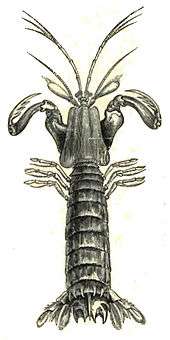
Mantis shrimp are long-lived and exhibit complex behaviour, such as ritualised fighting. Some species use fluorescent patterns on their bodies for signalling with their own and maybe even other species, expanding their range of behavioural signals. They can learn and remember well, and are able to recognise individual neighbours with whom they frequently interact. They can recognise them by visual signs and even by individual smell. Many have developed complex social behaviour to defend their space from rivals.
In a lifetime, they can have as many as 20 or 30 breeding episodes. Depending on the species, the eggs can be laid and kept in a burrow, or they can be carried around under the female's tail until they hatch. Also depending on the species, male and female may come together only to mate, or they may bond in monogamous long-term relationships.[42]
In the monogamous species, the mantis shrimp remain with the same partner for up to 20 years. They share the same burrow and may be able to coordinate their activities. Both sexes often take care of the eggs (biparental care). In Pullosquilla and some species in Nannosquilla, the female will lay two clutches of eggs: one that the male tends and one that the female tends. In other species, the female will look after the eggs while the male hunts for both of them. After the eggs hatch, the offspring may spend up to three months as plankton.
Although stomatopods typically display the standard types of movement seen in true shrimp and lobsters, one species, Nannosquilla decemspinosa, has been observed flipping itself into a crude wheel. The species lives in shallow, sandy areas. At low tides, N. decemspinosa is often stranded by its short rear legs, which are sufficient for movement when the body is supported by water, but not on dry land. The mantis shrimp then performs a forward flip in an attempt to roll towards the next tide pool. N. decemspinosa has been observed to roll repeatedly for 2 metres (6.6 ft), but specimens typically travel less than 1 m (3.3 ft).[43]
Culinary uses
In Japanese cuisine, the mantis shrimp species Oratosquilla oratoria, called shako (蝦蛄), is eaten boiled as a sushi topping, and occasionally, raw as sashimi.
Mantis shrimp are abundant in the coastal regions of south Vietnam, known in Vietnamese as tôm tít or tôm tech. In regions such as Nha Trang, they are called "bàn chải", named for its resemblance to a scrub brush. The shrimp can be steamed, boiled, grilled or dried; used with pepper, salt, and lime; fish sauce and tamarind; or fennel.[44]
In Cantonese cuisine, the mantis shrimp is known as "pissing shrimp" (Chinese: 瀨尿蝦; pinyin: lài niào xiā; Jyutping: laaih niu hā) because of their tendency to shoot a jet of water when picked up. After cooking, their flesh is closer to that of lobsters than that of shrimp, and like lobsters, their shells are quite hard and require some pressure to crack. Usually they are deep fried with garlic and chili peppers.
In the Mediterranean countries the mantis shrimp Squilla mantis is a common seafood, especially on the Adriatic coasts (canocchia) and the Gulf of Cádiz (galera).
In the Philippines, the mantis shrimp is known as tatampal, hipong-dapa, or alupihang-dagat, and is cooked and eaten like any other shrimp.
In Hawaii, some mantis shrimp have grown unusually large in the very dirty water of the Grand Ala Wai Canal in Waikiki. The usual dangers associated with consuming seafood caught in contaminated waters still applies to mantis shrimp.[3]
Aquaria
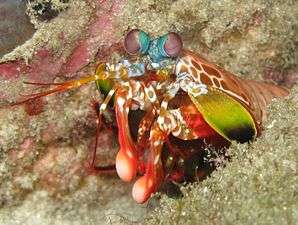
Some saltwater aquarists keep stomatopods in captivity.[45] The peacock mantis is especially colourful and desired in the trade.
While some aquarists value mantis shrimp, others consider them harmful pests, because:
- They are voracious predators, eating other desirable inhabitants of the tank,
- Some of the largest species can break aquarium glass by striking it
- Some rock-burrowing species can do more damage to live rock than the fishkeeper would prefer
The live rock with mantis shrimp burrows are actually considered useful by some in the marine aquarium trade and are often collected. It is not uncommon for a piece of live rock to convey a live mantis shrimp into an aquarium. Once inside the tank, they may feed on fish and other inhabitants. They are notoriously difficult to catch when established in a well-stocked tank,[46] and there are accounts of them breaking glass tanks. While stomatopods do not eat coral, smashers can damage it if they try to make a home within it.[8]
Example species
- Family Gonodactylidae
- Family Hemisquillidae
- Hemisquilla ensigera
- Family Lysiosquillidae
- Lysiosquillina maculata, zebra mantis shrimp or striped mantis shrimp, the largest species
- Family Nannosquillidae
- Family Odontodactylidae
- Odontodactylus scyllarus, peacock mantis shrimp
- Family Pseudosquillidae
- Pseudosquilla ciliata, common mantis shrimp
- Family Squillidae
- Family Tetrasquillidae
- Heterosquilla tricarinata, New Zealand
A large number of the mantis shrimp species were first scientifically described by one carcinologist, Raymond B. Manning, and the collection of stomatopods he amassed is the largest in the world, covering 90% of the known species.[47]
See also

References
- ↑ Joel W. Martin & George E. Davis (2001). An Updated Classification of the Recent Crustacea (PDF). Natural History Museum of Los Angeles County. p. 132.
- ↑ "Circular polarization vision in a stomatopod crustacean". Current Biology. 18. doi:10.1016/j.cub.2008.02.066.
- 1 2 James Gonser (February 14, 2003). "Large shrimp thriving in Ala Wai Canal muck". Honolulu Advertiser.
- ↑ "美國佛州漁民捕獲「巨蝦」 長46公分" (in Chinese). China Times. September 6, 2014. Retrieved September 2, 2015.
- ↑ Ross Piper (2007). Extraordinary Animals: An Encyclopedia of Curious and Unusual Animals. Greenwood Press. ISBN 0-313-33922-8.
- ↑ "Mantis shrimps", Queensland Museum
- ↑ Gilbert L. Voss (2002). "Order Stomatopoda: Mantis shrimp or thumb splitters". Seashore Life of Florida and the Caribbean. Dover pictorial archive series. Courier Dover Publications. pp. 120–122. ISBN 978-0-486-42068-4.
- 1 2 April Holladay (September 1, 2006). "Shrimp spring into shattering action". USA Today.
- ↑ "Stomatopoda". Tree of Life Web Project. January 1, 2002.
- 1 2 S. N. Patek, W. L. Korff & R. L. Caldwell (2004). "Deadly strike mechanism of a mantis shrimp" (PDF). Nature. 428 (6985): 819–820. Bibcode:2004Natur.428..819P. doi:10.1038/428819a. PMID 15103366.
- ↑ S. N. Patek & R. L. Caldwell (2005). "Extreme impact and cavitation forces of a biological hammer: strike forces of the peacock mantis shrimp". Journal of Experimental Biology. 208 (19): 3655–3664. doi:10.1242/jeb.01831. PMID 16169943.
- ↑ Mantis shrimp inspires next generation of ultra-strong materials, SpaceDaily.com, 1 June 2016, accessed 3 June 2016
- 1 2 3 4 5 Cronin, Thomas W.; Bok, Michael W.; Marshall, Nicholas Justin; Caldwell, Roy L. (January 6, 2014). "Filtering and polychromatic vision in mantis shrimps: themes in visible and ultraviolet vision". Philosophical Transactions of the Royal Society B: Biological Sciences. 369 (1636). doi:10.1098/rstb.2013.0032. eISSN 1471-2970. ISSN 0962-8436. PMID 24395960.
- 1 2 3 4 5 Franklin, Amanda M. (September 4, 2013). "Mantis shrimp have the world's best eyes – but why?". The Conversation. Retrieved July 5, 2018.
- ↑ Milius, Susan (2012). "Mantis shrimp flub color vision test". Science News. 182 (6): 11. doi:10.1002/scin.5591820609. JSTOR 23351000.
- ↑ Corwin, Thomas W. (2001). "Sensory adaptation: Tunable colour vision in a mantis shrimp". Nature. 411 (6837): 547–8. doi:10.1038/35079184. PMID 11385560.
- ↑ "Evolutionary variation in the expression of phenotypically plastic color vision in Caribbean mantis shrimps, genus Neogonodactylus". Marine Biology. 150. doi:10.1007/s00227-006-0313-5.
- 1 2 Thorn, Hanne H.; How, Martin J.; Chiou, Tsyr-Huei; Marshall, Nicholas Justin (January 24, 2014). "A Different Form of Color Vision in Mantis Shrimp". Science. 334 (6169): 411–413. Bibcode:2014Sci...343..411T. doi:10.1126/science.1245824.
- ↑ Marshall, Nicholas Justin; Oberwinkler, Johannes (October 28, 1999). "Ultraviolet vision: the colourful world of the mantis shrimp". Nature. 401 (6756): 873–874. Bibcode:1999Natur.401..873M. doi:10.1038/44751. PMID 10553902.
- 1 2 Michael Bok; Megan Porter; Allen Place; Thomas Cronin (2014). "Biological Sunscreens Tune Polychromatic Ultraviolet Vision in Mantis Shrimp". Current Biology. 24 (14): 1636–42. doi:10.1016/j.cub.2014.05.071. PMID 24998530.
- ↑ Mantis shrimp wear tinted shades to see UV light. Latimes.com (2014-07-05). Retrieved on 2015-10-21.
- ↑ David Cowles; Jaclyn R. Van Dolson; Lisa R. Hainey; Dallas M. Dick (2006). "The use of different eye regions in the mantis shrimp Hemisquilla californiensis Stephenson, 1967 (Crustacea: Stomatopoda) for detecting objects". Journal of Experimental Marine Biology and Ecology. 330 (2): 528–534. doi:10.1016/j.jembe.2005.09.016.
- 1 2 3 4 "The molecular genetics and evolution of colour and polarization vision in stomatopod crustaceans". Ophthalmic Physiology. 30.
- 1 2 DuRant, Hassan (3 July 2014). "Mantis shrimp use 'nature's sunblock' to see UV". sciencemag.org. Retrieved 5 July 2014.
- ↑ Cronin, Thomas W.; Marshall, Justin (2001). "Parallel processing and image analysis in the eyes of mantis shrimps". The Biological Bulletin. 200 (2): 177–183. doi:10.2307/1543312. JSTOR 1543312. PMID 11341580.
- ↑ Chiou, Tsyr-Huei; Kleinlogel, Sanja; Cronin, Tom; Caldwell, Roy; Loeffler, Birte; Siddiqi, Afsheen; Goldzien, Alan; Marshall, Justin (March 25, 2008). "Circular polarization vision in a stomatopod crustacean". Current Biology. 18 (6): 429–434. doi:10.1016/j.cub.2008.02.066. PMID 18356053.
- 1 2 Kleinlogel, Sonja; White, Andrew (2009). "The secret world of shrimps: polarisation vision at its best". PLoS ONE. 3 (5): e2190. arXiv:0804.2162. Bibcode:2008PLoSO...3.2190K. doi:10.1371/journal.pone.0002190. PMC 2377063. PMID 18478095.
- ↑ Templin, Rachel M.; How, Martin J.; Roberts, Nicholas W.; Chiou, Tsyr-Huei; Marshall, Justin (June 30, 2017). "Circularly polarized light detection in stomatopod crustaceans: a comparison of photoreceptors and possible function in six species". Journal of Experimental Biology. 220 (18): 3222–3230. doi:10.1242/jeb.162941. eISSN 1477-9145. ISSN 0022-0949. PMID 28667244.
- ↑ Roberts, Nicholas W.; Chiou, Tsyr-Huei; Marshall, Nicholas Justin; Cronin, Thomas W. (2009). "A biological quarter-wave retarder with excellent achromaticity in the visible wavelength region". Nature Photonics. 3 (11): 641–644. Bibcode:2009NaPho...3..641R. doi:10.1038/nphoton.2009.189.
- ↑ Lee, Chris (November 1, 2009). "A crustacean eye that rivals the best optical equipment". Nobel Intent. Ars Technica.
- ↑ Minard, Anne (May 19, 2008). ""Weird beastie" shrimp have super-vision". National Geographic Society.
- ↑ "Mantis shrimp have perfected the eye roll to see things we can't imagine". 14 July 2016.
- ↑ "The Evolution of Complexity in the Visual Systems of Stomatopods: Insights from Transcriptomics". Integrative and Comparative Biology. 53. doi:10.1093/icb/ict060.
- ↑ "Evolution of anatomical and physiological specialization in the compound eyes of stomatopod crustaceans". Journal of Experimental Biology. 213.
- ↑ Bristol University: Mantis shrimps could show us the way to a better DVD, 25 October 2009. Bristol.ac.uk (2009-10-25). Retrieved on 2015-10-21.
- ↑ C. H. Mazel; T. W. Cronin; R. L. Caldwell; N. J. Marshall (2004). "Fluorescent enhancement of signaling in a mantis shrimp". Science. 303 (5654): 51. doi:10.1126/science.1089803. PMID 14615546.
- ↑ Mantis shrimp's super colour vision debunked. Nature.com (2014-01-23). Retrieved on 2015-10-21.
- ↑ Stephen L. Macknik (March 20, 2014) Parallels Between Mantis Shrimp and Human Color Vision. Scientific American
- ↑ T. York; S. Powell; S. Gao; L. Kahan; T. Charanya; D. Saha; N. Roberts; T. Cronin; J. Marshall; S. Achilefu; S. Lake; B. Raman; V. Gruev (2014). "Bioinspired polarization imaging sensors: from circuits and optics to signal processing algorithms and biomedical applications". Proceedings of the IEEE. 102 (10): 1450–1469. doi:10.1109/JPROC.2014.2342537. PMC 4629637.
- ↑ "Nature's elegant and efficient vision systems can detect cancer". University of Queensland. September 22, 2014. Retrieved November 21, 2014.
- ↑ New type of optical material discovered in the secret language of the mantis shrimp. Bristol University ( 17 February 2016)
- ↑ "Sharing the job: monogamy and parental care". University of California, Berkeley.
- ↑ Caldwell, Roy L. (1979). "A unique form of locomotion in a stomatopod – backward somersaulting". Nature. 282 (5734): 71–73. Bibcode:1979Natur.282...71C. doi:10.1038/282071a0.
- ↑ "Tôm tít – Đặc sản miền sông nước" (in Vietnamese). Dinh dưỡng. October 1, 2009. Retrieved January 8, 2011.
- ↑ A Load of Learnin' About Mantis Shrimps, by James Fatherree, in ReefKeeping online magazine.
- ↑ Nick Dakin (2004). The Marine Aquarium. London: Andromeda. ISBN 1-902389-67-0.
- ↑ Paul F. Clark & Frederick R. Schram (2009). "Raymond B. Manning: an appreciation". Journal of Crustacean Biology. 29 (4): 431–457. doi:10.1651/09-3158.1.
External links
- Hoplocarida: Stomatopoda fact sheet—Guide to the marine zooplankton of south eastern Australia
- The Lurker's Guide to Stomatopods—mantis shrimp
- Mantis shrimp—colourful and aggressive
- Research on Stomatopods at the University of Maryland
- "Mantis shrimp". The Aquarium Wiki. April 7, 2006.
- Caldwell Lab at the University of California, Berkeley
- Patek Lab at the University of Massachusetts, Amherst
- P. Z. Myers (May 24, 2008). "The superior eyes of shrimp". Pharyngula. Archived from the original on September 12, 2009.
- Daniel Cressey (May 14, 2008). "Shrimp's super sight". The Great Beyond. nature.com.
- Dana Point Fish Company—Top and Bottom Views of Mantis Shrimp
- TED talk
- Deep Look (PBS)